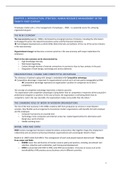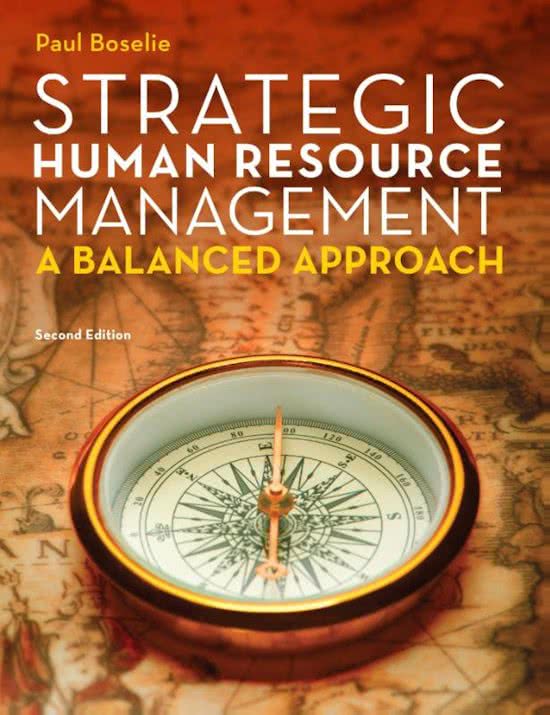CHAPTER 1: INTRODUCTION: STRATEGIC HUMAN RESOURCE MA NAGEMENT IN THE
TWENTY-FIRST CENTURY
‘Employees matter and […] the management of employees – HRM – is a potential source for achieving
organizational goals.’
THE NEW ECONOMY
The new economy (approx. 1990) is dominated by emerging branches of industry, including the information
technology (IT) sector, the telecommunications sector and the financial institutions.
Technological developments as World Wide Web (Internet) are facilitator of the rise of the service industry
in the new economy.
Organizational change had become a common practice in the new economy with major implications for
employees.
Work in the new economy can be characterized by:
o High knowledge intensity;
o Web-based organizing;
o Contact through intranet of internet connections in contrast to face-to-face contacts in the past
o Integration of work design, technology and service delivered.
ORGANIZATIONAL CHANGE AND COMPETITIVE ADVANTAGE
The relevance of optimal coping with change is embedded with Competitive advantage.
Competitive advantage is important for organizational survival and is at least partly manageable by HRM.
Competitive advantage represents an organization’s position in comparison to its direct
competitors.
The concept of competitive advantage represents a relative outcome:
‘’An organization with competitive advantage is doing better than its competitors irrespective of the actual firm
performance (negative or positive). In the case of losses, the organization is still doing better than its
competitors. And in the case of profits, the organization makes more profits than the others.’’
THE CHANGING ROLE OF WORK IN MODERN ORGANIZATIONS
The rise of the new economy in the 1990s created a shift from production to services in most Western
societies. New flexible work arrangements characterize modern organizations with benefits for both employer
and the employee:
o Computer has become an essential tool;
o Technology, home computers and internet access has created opportunities for alternative work
design (e.g. work at home)
o Flexible working hours
MHRM, IHRM AND SHRM
HRM involves management decisions related to policies and practices that together shape the employment
relationship and are aimed at achieving individual, organizational and societal goals linked to them.
Boxall et al. (2007) state that HRM is ‘the management of work and people towards desired ends’. There are
three major sub-fields:
o MHRM covers the sub-function of human resource policy and practice, including recruitment and
selection, induction and socialization, and training and development.
o IHRM is concerned with HRM in MNCs and HRM across borders. It focuses on issues such as the
transferability of HR practices across business units in different countries.
1
, o SHRM focuses on issues of linking HRM to the business strategy, designing high-performance work
systems (HPWSs) and assing value through good people management in an attempt to gain sustained
competitive advantage.
There are major differences between countries as a result of differences in legislation. Legislation potentially
affects people management and HRM.
THREE PERSPECTIVES
The multidimensional strategic HR model in this book includers the following key characteristics:
o A multi-actor perspective: multiple stakeholders including employees, managers, HR professionals,
work councils, trade unions, top management, shareholders, financiers and government.
o A broad societal view: with an emphasis on different institutional contexts, for example on the level
of branches of industry, regions and countries;
o A multi-level perspective: including the individual employee perspective and the strategic
organizational perspective.
HRM involves the administration related to legislation and the relationship management with crucial social
partners including works councils and trade unions.
HRM focuses on the exchange relationship between the employee and the organization.
The employment relationship contains different contract types:
1. Legal contract (e.g. rights and obligations within the organization);
2. Economic or transactional contract (salary);
3. Psychological contract (e.g. investing extra time in a project for internal promotion);
4. Sociological contract (bond with the team);
TENSIONS
HRM operates in an area of continuous tension between added value and moral values.
Added values represent the economic side of organization work and mainly represent the role of
HRM in increasing financial performance for an organization.
Moral values reflect the notions of employees as human beings with feelings, emotions, etc.
Boxall and Purcell’s (2003) argue that:
o HRM covers all workforce groups, including core employees, peripheral employees and contingent
workers;
o HRM involves line and specialist managers, and is not solely aimed at employees;
o HRM is all about managing work and people. Collectivity and individually;
o HRM is embedded in industries and societies.
Traditionally, a distinction is made between Anglo-Saxon or Anglo-American models and the Rhineland
models.
o Anglo-American models approache in IR and HRM, for example in the USA, mainly focus on creating
shareholder value in terms of profits and market value with little or no attention to other
stakeholders.
o Rhineland models acknowledge multiple stakeholders and their interests explicitly talking in to
account employee interests in term of well-being and societal interests.
THE BALANCED APPROACH
In the strategic balance model, organizational success can only be achieved when financial performance and
societal performance of an organization are above average in the particular population in which the
organization is operating.
An overview of different views on HRM is listed below:
o Human resources are more than just resources;
o HRM is not concerned solely with financial performance;
2
, o HRM focuses on the exchange relationship between the employee and the organization;
o The shaping of the employment relationship takes place in an era of continuous tension between the
added value and moral value;
o HRM covers all workforce groups;
o HRM involves line and specialist managers, and is not solely aimed at employees;
o HRM is focused on managing work and people, collectivity and individually;
o HRM is embedded in industries and societies.
FRAMING HRM
Frames can be considered as mental models, maps, mindsets, cognitives lensens that people apply consciously
but mostly unconsciously. Bolman and Deal (2008) present four different perspectives of frames for studying
organizations:
1. Structural frame: This frame seeks to gain an understanding of the various parts of an organization.
2. Employment relationship (HR): represents a specific way of looking at organizations mainly focused
on concepts such as needs, skills and relationships.
3. Political frame: examines issues of power. Conflict, power and competition are leading concepts.
4. Symbolic frame: builds on meaning and identity like culture, ritual, ceremony, stories and heroes.
Mainstream SHRM is mostly studied from the structural or HR frame, the political and symbolic frame are
largely neglected in the SHRM frame. See table 1.1 at p.12.
Also see the glossary of key terms at page 14.
3
, CHAPTER 2: STRATEGIC HUMAND RESOURCE MANAGEMENT AND CONTEXT
BEST PRACTICE VERSUS FIT
There is an ongoing debate about the relevance and necessity of fit between HRM and other aspects of an
organization (Boxall and Purcell, 2008). To fit or not to fit appears to be one of the key points of attention in
the field of SHRM over the last two decades.
The theoretical debate linked to this issue of fit (or not) is known for its two competing schools:
o The ‘best-fit’ school: argues that HRM is more effective when it is aligned with its internal and
external context;
o The ‘best-practice’ school: advocates a universalistic perspective: it argues that all firms will be better
off if they identify and adopt ‘best practice’ in the way they manage people.
ILLUSTRATIONS OF PFEFFER’S SEVEN BEST PRACTICES IN PRACTICE
Pfeffer’s (1998) seven HR practices for ‘building profits by putting people first’ is representative of the ‘best-
practice’ school. His seven practices are:
o Selective recruitment and selection: might involve a combination of different techniques, intelligence
tests, integrity tests, assessments etc.
o Extensive training: may involve employee development through training programmes outside the
organization, training on the job, etc.
o Performance-related pay (PRP): linked to the profits of the organization, bonus for the best-
performing employee, etc.
o Teamworking: with autonomy and self-responsibility. It is a way to break through the hierarchical
model and decentralize responsibility.
o Information sharing and communication: using internet, newsletters, direct supervisor talks, top
management presentations etc.
o Reduction of status differences: through avoiding status symbols linked to hierarchical positions such
as executive parking spaces etc.
o Employment security: in terms of employee benefits providing insurance of unemployment, disability
and death for employees and their families.
Pfeffer (1998) claims success for all companies that applies these seven practices in HRM.
Pfeffer’s best-practice proposition (one size fits all in HRM) is both supported by empirical research and
criticized for its lack of attention to contextual factors, including national differences with regard to labor
legislation, sector differences, etc.
The strength of this model is its simplicity and clarity (Paauwe, Guest and Wright, 2013).
In contrast, the best-fit proposition (HRM’s success depends on the alignment of it with the organizational
context) stresses the contextual embeddedness of HRM organizations.
Context represents the set of facts or circumstances that surrounds the organization.
Internal context: organization’s history, administrative heritage, organization culture
External context: reflects the outside mechanisms; market mechanisms and institutional
mechanisms.
Business model = the way an organization manages its business to make money. An optimal fit between HRM
and the context can positively affect the business model and the organizational success.
A better fit can be achieved through strategic decision making.
Strategy = an organization’s intention to achieve certain goals through planned alignment (or fit) between the
organization and its environment (De Wit and Meyer, 1998).
An optimal strategy includes a fit between HRM and the context. This strategy contributes to the
organization’s business model and its performance.
Goals are another important concept in strategy. Goals can be defined in broader terms like organizational
goals, societal goals, individual employee goals. This view is also reflected in some of the theoretical HRM
models including Beer et a. (1984), Paauwe (1991), and Boselie (2002), see figure 2.1 p.23
4





